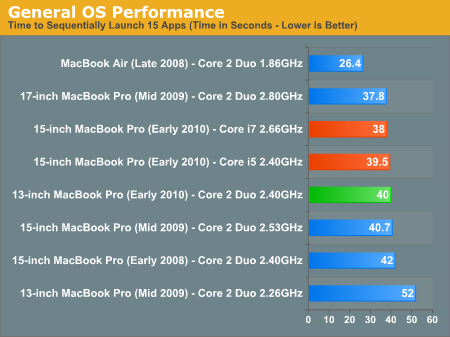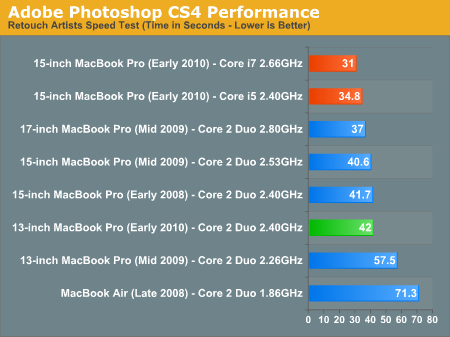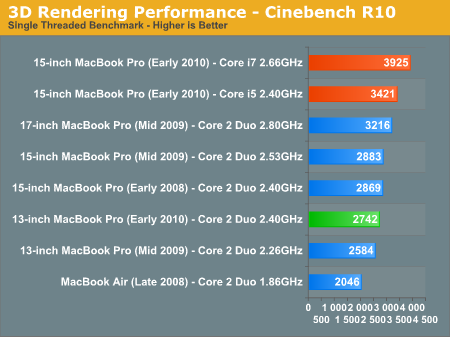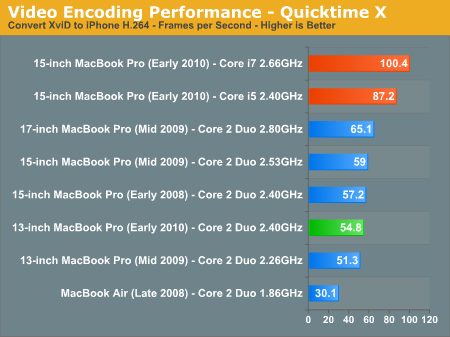Apple's 13-inch MacBook Pro (Early 2010) Reviewed: Shaking the CPU/GPU Balance
by Anand Lal Shimpi on June 9, 2010 12:15 AM EST- Posted in
- Mac
- Apple
- Intel
- MacBook Pro
- NVIDIA
General Performance: A Mild Improvement
We know what the GPU upgrade is good for, but what about the mild CPU bump in the 2010 13-inch MacBook Pro?
General OS usage is a difficult thing to quantify, but one measure of performance has always been the number of bounces an icon in the dock makes before an application loads. I decided to take it to the next level and write a quick script to launch 15 applications in a row, timing how long the entire process takes.
I launched, in order: Mail, Safari, Activity Monitor, iTunes, iCal, DVD Player, iPhoto, Photo Booth, Quicktime Player, Disk Utility, Preview, iMovie, Front Row, Garage Band and Aperture.
The entire process stresses both the disk and CPU, which is why we see a huge improvement when going to an SSD as well as differences between CPU speeds.

Application launch performance improves tremendously compared to last year's model thanks to the now standard 4GB of memory. The 2GB last year's model came with just wasn't enough. Now if you upgraded your previous gen 13-inch MBP then you'll hardly notice a performance improvement.
Also pay attention to just how well the Late 2008 MacBook Air does in this test. That's thanks to its SSD. Add an SSD to any of these notebooks and you'll see a similarly awesome increase in performance.
Adobe Photoshop CS4 Performance
The Retouch Artists Speed Test we use for our CPU testing under Windows also works under OS X. We're running the exact same benchmark here, basically performing a bunch of image manipulations and filters and timing the entire process.

Start doing real work with the 13-inch MacBook Pro and you'll note that it's significantly slower than the new 15-inch models. The Core i5 just rocks. Compared to last year's model the new MBP is much faster, but again that's due to the 4GB vs. 2GB of DDR3 that comes standard with the machine. An upgraded 2009 13-inch MBP would be basically the same speed.
Aperture 2 RAW Import
For my Aperture test I simply timed how long it took to import 203 12MP RAW images into the library.

Photographers and digital media creation professionals will want to opt for the 15-inch MacBook Pro, the faster CPU is definitely worth it.
Cinebench R10

In situations where we're not memory bound, the improvement over the previous generation 13-inch model is small. The performance improvement here is 6%. I'd say in most apps you'd see a 2 - 4% improvement over the 2.26GHz 13-inch from last year.

Quicktime H.264 Video Encoding
Our final benchmark is more consumer focused. Here I'm taking an XviD and converting it to an iPhone-supported H.264 format.

Encoding performance is improved over last year's 2GB/2.26GHz model, but no where near as much as the Core i5/i7 managed with the 15-inch model. If you're doing anything CPU intensive, the new 13-inch MacBook Pro isn't an upgrade.










93 Comments
View All Comments
cheinonen - Wednesday, June 9, 2010 - link
Why do people treat Apple like they're the only person that uses Foxconn? HP, Dell, and others use them as well. I'm not excusing anything at Foxconn, but to single out Apple as only being able to do this because of who they use for manufacturing, when most other top companies use the same vendor, is ridiculous.james.jwb - Wednesday, June 9, 2010 - link
@jabberYour comment pretty much applies to 80% of everything you buy, period. You are living in a bubble and possibly even a hypocrite to get on your high horse about this product, or Foxconn so singularly.
But hey, it is being heavily talked about at the moment and it is in your face, so good for you for having this fleeting feeling of misplaced superiority that will no doubt disappear just as quickly as the misplaced headlines.
jabber - Thursday, June 10, 2010 - link
Fully aware that any electronic device has blood sweat and tears on it so I am fortunate enough to purchase it.I have been very aware of this for years.
However, it's been pretty apparent that many havent been aware of this and seem to wish to keep their heads in the sand so they dont have to feel guilty about it.
"I dont care what goes on as long as I get my new iPhone upgrade gimme gimme!"
The suicides at Foxconn are not necessarily Foxconn's fault.
It's OUR fault!
Our fault for wanting to only pay the minimum for more and more good such as these Macbooks, motherboards, GPUs etc. etc.
I just hope from events this past few weeks might make a few people think a little bit more before they purchase their next unnecessary electronic gadget.
Same goes for cheap, shoes, clothes, jewellry etc.
zorxd - Wednesday, June 9, 2010 - link
95% of mac users don't use their GPU. The Intel GMA HD GPU would have been more than enough for this kind of laptop. The Geforce 320M is too slow for gaming anyways so I don't see the point.jabber - Wednesday, June 9, 2010 - link
Noooo, dont be silly. The Geforce 105M in my Dell is more than enough to play a lot of the games I mess around with such as BF2 and Eve online. Eve plays at high settings and gives around 60fps.We dont all play Crysis and Call Of Donkey Modern Warfare 4 whatever.
Ninjahedge - Wednesday, June 9, 2010 - link
Maybe more would if it HAD a GPU to begin with.If the current Mac users do not buy their machine to game on (or any other GPU intensive task) because there is no good GPU present, what is to say they will not buy and utilize it if it is included?
KoolAidMan1 - Thursday, June 10, 2010 - link
Not true, the OS X desktop has always leaned heavily on the GPU. The other thing is OpenCL which shipped with OS 10.6. Apple has to be prepping some major GPU computing in the next version of OS X, especially since it is a part of 10.6.I believe this is the "thing" Anand is waiting for, we'll see. It makes sense why Apple would put such a relatively high baseline on their GPUs, otherwise they'd just go with the Arrandale's anemic graphics and call it a day.
bang222 - Wednesday, June 9, 2010 - link
They took away support for jumbo frames in the Broadcom ethernet chip.:-(
Big minus if you tune your NAS.
CharonPDX - Wednesday, June 9, 2010 - link
Uh, I call bull.
Apple fit a three-chip solution in the first MacBook Air. Yes, the CPU was on a smaller mount, but it was still a three-chip solution on a microscopic board. If they really wanted to, they could slap a three-chip solution in the 13" MBP.
solipsism - Wednesday, June 9, 2010 - link
1) The MBA had the CULV C2D and GMA950 or 9400M. That's two!2) The MBA is 13" but it also using a SFF chip, has low power and low heat, thereby needs less venting and can use a smaller fan and heatsink.
3) The MBA has a 1.8" drive, not a 2.5" drive.
4) The MBA has no optical drive whilst the MB and 13" MBP do.
— MBA internals: http://s1.guide-images.ifixit.com/igi/WPhHIikf5jBW...
— MBA MoBo: http://www.ifixit.com/igi/KJJyYGCKwbfhmAJI
— 13" MBP internals: http://s2.guide-images.ifixit.com/igi/FkpKKrqQlYsg...
— 13" MBP MoBo: http://s1.guide-images.ifixit.com/igi/XaPYhlwqukef...
If you're going to call "bull" then i assume that you have detailed info as to where all this extra room is that a Core-i chip + dGPU + additional fan would go in this system.
it seems to me that the only way they could add the items you think are so easily included which altering the dimensions of the internal space is to reduce the size of the battery (which is still too lower than most people would like it to be at) or remove the optical drive (which oft goes unused, is slow, mote prone to break due to moving parts, and takes up 25% of the internal space). I'm going with the latter.